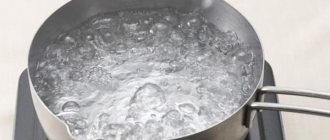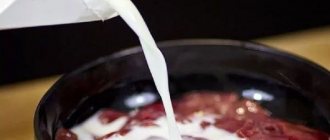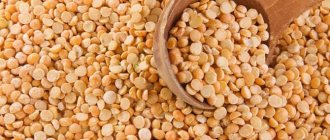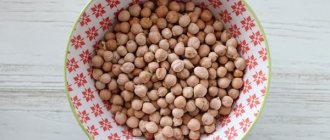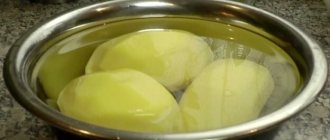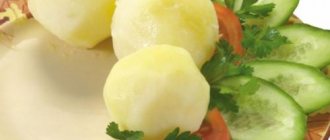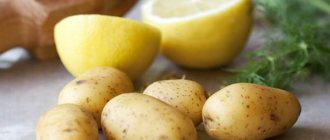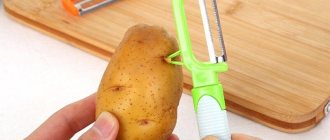Health
Lifehacks
Products
Adviсe
Life without potatoes is not life. Imagine how many amazing dishes we would lose if potatoes were removed from cooking! Unfortunately, fewer and fewer people grow their own crops and more and more people buy this delicious product in stores. However, the quality of such potatoes leaves much to be desired...
Experts recommend that all purchased potatoes be soaked in water before cooking. These recommendations especially apply to people with allergies, diabetics and young children. Why do you need to soak potatoes , what is the reason for this and how to do it correctly, find out from this article.
Cooking recommendations
If eating potatoes is not associated with the occurrence of negative reactions, you can eat them every day, but not more than 200 g. People with high blood sugar, gout and young children should limit their consumption to 100 g per week. Regardless of the cooking method, it is better to soak the potatoes.
To maintain the usefulness of the product and achieve the best taste, you can use the following tips:
- To prevent the skin of the tuber in its uniform from bursting, add a couple of drops of vinegar to the water.
- To speed up cooking, add a piece of butter (margarine) to the pan.
- To make the tubers lighter, you need to add 1 tsp during cooking. lemon juice.
- Purees should be eaten fresh. During heat treatment, it loses 30% of vitamin C, and when heated again, there will be no vitamins left in it.
- To obtain tasty and crumbly boiled potatoes, you need to pour salted boiling water over the soaked tubers.
- To minimize the amount of nitrates in store-bought potatoes, it is necessary to remove the skin in a thick layer. For an environmentally friendly product, another rule is to peel it as thinly as possible, and better yet, eat it with the peel, since it contains more vitamins than a peeled tuber.
- Frozen potatoes will lose their unpleasant taste if they are consumed no earlier than a week after storage at room temperature.
- Soaked potatoes are good to eat raw. It is recommended for cancer patients, people with increased swelling, metabolic disorders, and gum disease. Grated tubers can be mixed with apples and seasoned with lemon juice and honey. An important condition is the absence of pesticides.
We recommend: How long does it take to cook beef and how to cook it correctly?
Potatoes allow you to diversify your menu and saturate your body with useful microelements. If according to indications the tubers are prohibited from being eaten, soaking will correct the situation. Without starch and pesticides, potatoes are good for everyone.
ingenious ways to remove starch from everyday food; From rice to potatoes and more!
Basic moments
- Starch makes up the majority of our diet
- Many health experts do not recommend consuming starchy foods every day
- Vegetables rich in starch and sugar, usually low in protein
Starch makes up a large part of our diet, mainly because most foods contain starch, which is made up of sugar and carbohydrates. Everyday foods such as potatoes, corn, peas, sweet potatoes, rice, etc. can contain large amounts of starch.
Starch is quickly metabolized, causing blood sugar levels to rise immediately after eating. Although starchy foods are an important source of energy, they should be consumed in moderation to reap their benefits. Many health experts do not recommend eating starchy foods every day as they can interfere with digestion and raise blood sugar levels, which can be dangerous for diabetics. Why do you need to remove starch from vegetables?
Vegetables rich in starch and sugar are typically low in protein, which when cooked at high temperatures creates a toxic substance, acrylamide, that impairs brain health. High starch content also increases sugar levels, which can lead to the potential development of diabetes, obesity and other health hazards . While some carbohydrates are used by the body, unused ones are stored as fat. Hence, it is extremely important to get rid of the starch in these foods so that you can consume them without thinking about any consequences.
Vegetables that are high in starch and sugar tend to be low in protein. Most vegetables, such as potatoes, peas, corn, sweet potatoes, and pumpkin, contain starch. The ideal way to get rid of starch is to soak it a little. Soaking these vegetables can help reduce acrylamide levels, making them a little healthier. According to a study published in the Journal of the Science of Food and Agriculture, soaking these vegetables for at least two hours before cooking reduces acrylamide levels by 48 percent. Moreover, soaking can remove any pesticides from them and reduce toxicity.
Soak the rice for 30-40 minutes and then rinse it to reduce the starch content. Another food item that contains the highest amount of starch is rice. All you need to do is rinse the rice thoroughly in cold water to remove dirt and some starch. Fill the pan with cold water depending on the amount of rice. Bring water to a boil, adding salt if desired. When the water boils, add the rice and let it cook for two to three minutes. Now rinse the rice in cold water. While rinsing, you will notice white water, which indicates the presence of starch. Continue rinsing the rice until the water runs clear. Place the pan back on the stove over low heat. Cover the pan with a lid to ensure the rice steams properly. Remember that this can only be done when the rice is not soaked before cooking. Another method is to soak the rice for 30-40 minutes and then rinse it to reduce the starch content.
The same method should be used to remove starch from legumes, grains and pasta. These simple and traditional methods not only help in reducing the starch content but also make them healthier to consume such foods on a daily basis. Go ahead and enjoy your portion of destarched vegetables and rice.
Increased
.
How to make potato starch
Sebalos/iStock/GettyImages
Potato starch often appears in gluten-free recipes as a thickening agent in place of flour. This isn't always common at the grocery store, but you can make it yourself at home. The amount of starch produced from this process depends on the age and type of potato used. For best results, use large russet potatoes that are high in starch.
Line a colander with two layers of cheesecloth and place the colander over the bowl.
Grate the potatoes through the smallest holes on the grater.
Fold the ends of the gauze up and cover the potatoes.
Press down on the cheesecloth until the starchy liquid from the potatoes drips into the bowl.
Open the cheesecloth and pour 1/2 cup of water over the potatoes.
Cover again with cheesecloth and squeeze the potatoes to drain into the bowl.
Repeat steps 5 and 6 with remaining 1/2 cup water.
Place two jars on cheesecloth and leave for 1-2 hours to squeeze more starch out of the potatoes.
Remove the colander and discard the cheesecloth and potatoes.
Carefully pour the liquid into a separate container, being careful not to disturb the starch that has settled at the bottom of the first container.
Drain and allow remaining potato starch to dry before using.
.
Why are potatoes soaked?
Nutritionists advise everyone, without exception, to soak potatoes before cooking, but there are people who are strictly forbidden to eat tubers without prior processing.
Soaking potatoes allows you to:
- Reduce the glycemic index (GI). This is important for diabetics. Products whose GI does not exceed 50 are allowed for consumption. In potatoes, the index reaches 70–80 (in sugar - 75), which makes the product completely unsuitable for citizens with a diagnosed disease. One could avoid potatoes altogether, but they contain many substances that support the patient’s body. The only way to introduce tuber dishes into the diet is to eliminate starch. After soaking, the GI drops by 25–30 units.
- Reduce the allergenicity of the product. Cases of negative reactions are rare, but if they are present, there is a high risk of allergies to other nightshades: eggplants, peppers, tomatoes. In adults, allergies have many manifestations: rash, symptoms of respiratory disease, swelling. Infants suffer from rashes and colic. Once a reaction is detected, consumption of potatoes should be stopped, and after 3-4 months, resumed, using only environmentally friendly soaked product. A nursing mother should also stop eating potatoes if her child shows signs of an allergy.
- Reduce calories. 100 g of starch contains approximately 357 calories. Potatoes are 83% pure fast carbohydrates that promote weight gain, and removing starch reduces calories.
- Remove nitrates. It has been proven that soaking allows you to get rid of growth stimulants that have a detrimental effect on humans.
In multi-colored varietal potatoes (pink, purple), the level of sugars and starch is 30% lower than in light varieties, so their use is preferable.
How to soak potatoes before cooking?
For consumption, you need to select whole tubers without dents or signs of spoilage. You should pay attention to the color of the peel. If it is greenish, it means that the tuber has a high concentration of a toxic substance - solanine. Even in small quantities, it causes inflammation of the gastric mucosa, destroys red blood cells, and destabilizes the functioning of the nervous system.
We recommend: Refined and unrefined oil in the kitchen – which is better and healthier?
After selecting high-quality tubers, you need to:
- Wash and peel the tubers, cut into several pieces. If the method of growing potatoes is known and the use of nitrates is excluded, you can cook potatoes in their jackets. It must be thoroughly washed and cut into 2-4 parts depending on the size of the potato.
- Pour in water until the liquid completely covers the contents of the container with tubers. Leave to wash out the starch for 60 minutes.
- Drain the water and repeat the process: pour in, leave for an hour. Afterwards, drain.
- Fill the tubers with clean water. Starch removal time is 12 hours. Afterwards, drain the water and prepare the dish.
The smaller the potatoes are cut before soaking, the easier the starch will come out of them. The processing time can be reduced by 4 times if you grate the tubers on a coarse grater before the procedure.
Action of carbohydrates
But sometimes disputes over the use of potatoes by diabetics still arise due to the special effect of carbohydrates on the patient’s body. Carbohydrates are divided into simple and complex:
- Simple. The human body absorbs this substance quite easily. After entering the blood, it begins to change the amount of sugar in it, increasing it.
- Complex (polysaccharides). They are absorbed much more slowly, and some of their components may not be accepted by the body. This element is found in corn, cereals, and potatoes. With abundant consumption of junk food, fat reserves increase in the human body, which is undesirable not only for diabetics, but also for people who do not have such a disease.
The human body, both healthy and sick, needs the right amount of carbohydrates in its daily menu. This useful component is found in fruits, legumes, vegetables, and also in cereals. But people diagnosed with diabetes should be extremely careful when consuming various foods, such as potatoes.
